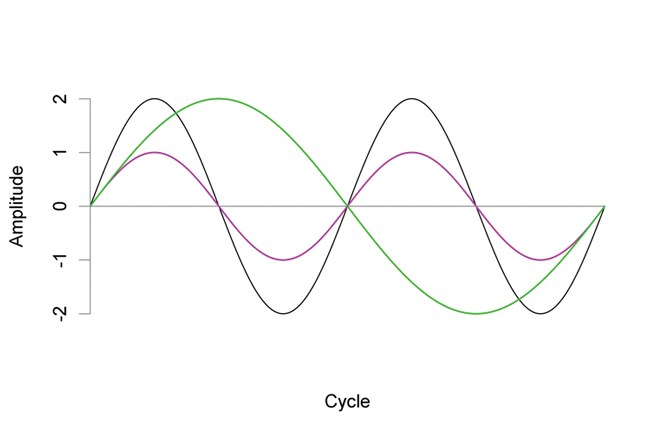what term refers to the high and low frequencies that we hear in music?

NPS
Defining Fundamental Terms
Audio moves through a medium such equally air or h2o as waves. It is measured in terms of frequency and amplitude.
Frequency, sometimes referred to as pitch, is the number of times per second that a sound pressure wave repeats itself. A drum beat has a much lower frequency than a whistle, and a bullfrog call has a lower frequency than a cricket. The lower the frequency, the fewer the oscillations. High frequencies produce more oscillations. The units of frequency are chosen hertz (Hz). Humans with normal hearing can hear sounds between twenty Hz and twenty,000 Hz. Frequencies above twenty,000 Hz are known as ultrasound. When your dog tilts his head to mind to seemingly imaginary sounds, he is tuning in to ultrasonic frequencies, as high every bit 45,000 Hz. Bats can hear at amidst the highest frequencies of any mammal, up to 120,000 Hz. They use ultrasonic vocalizations every bit sonar, allowing them to pursue tiny insects in the dark without bumping into objects.
At the other end of the spectrum are very low-frequency sounds (below xx Hz), known as infrasound. Elephants use infrasound for advice, making sounds likewise low for humans to hear. Considering low frequency sounds travel farther than high frequency ones, infrasound is platonic for communicating over long distances.

NPS / Damon Joyce
Amplitude is the relative forcefulness of sound waves (transmitted vibrations), which we perceive equally loudness or volume. Amplitude is measured in decibels (dB), which refer to the acoustic level or intensity. The lower threshold of human hearing is 0 dB at 1kHz. Moderate levels of audio (a normal speaking vocalization, for case) are nether threescore dB. Relatively loud sounds, similar that of a vacuum cleaner, measure around 70 dB. When workplace sound levels reach or exceed 85 dB, employers must provide hearing protection. A rock concert, at around 125 dB, is pushing the human pain threshold.
Encounter Types of Data for data on how NPS acoustic technicians apply frequency and amplitude in field assessments.
Decibels are measured on a logarithmic calibration, and so an increase of x dB causes a doubling of perceived loudness and represents a x-fold increment in audio level (Crocker, 1997). In other words, if the sound of one vacuum cleaner measures seventy dB, eighty dB would be the equivalent of 10 vacuum cleaners.
Acoustic resources are physical audio sources, including both natural sounds (wind, water, wildlife, vegetation) and cultural and historic sounds (battle reenactments, tribal ceremonies, quiet reverence). Soundscape tin can be defined as the human being perception of those concrete sound resources. Like dazzler, soundscapes are in the heed of the beholder. The rhetorical question about the tree that falls in the forest may help illustrate this. Because no man is there to hear it, the resulting crash is not a part of the homo soundscape. Information technology is however, a pretty meaning part of the soundscape of the squirrel standing in the tree's path.
The audio-visual environs is the combination of all the audio-visual resources inside a given area. This includes natural sounds and cultural sounds, as well as non-natural human being-caused sounds. The sound vibrations made by our imaginary falling tree are a part of the acoustic surround regardless of whether a human is there to perceive them. Bat echolocation calls, while outside of the realm of the man soundscape, are also part of the acoustical surround. It is therefore critical to have the entire acoustic environment into business relationship when working to protect natural sounds.
Considering the acoustic environment is made upward of many sounds, the fashion nosotros experience the acoustic surroundings depends on interactions between the frequencies and amplitudes of all the sounds. Sound levels are often reduced or adjusted ("A-weighted") to match the hearing abilities of a human being or given animal. Audio levels adapted for human being hearing are expressed every bit dB(A).
Sound Level
Noise is sometimes used every bit a synonym for audio, but there is a difference. Dissonance is a sound that is unwanted or inappropriate in an environment. In national parks, noise sources can range from machinary and tools used for maintenance, to visitors talking too loud on the trail, to shipping and other vehicles. Parks work to reduce noise in park environments.
Audio levels in national parks tin vary greatly, ranging from among the quietest e'er monitored to extremely loud. While the din of a typical suburban expanse fluctuates between 50 and 60 dBA, the crater of Haleakala National Park is intensely quiet, with levels hovering around 10 dBA. Along some remote trails in Yard Coulee National Park, audio levels, at 20 dBA, are softer than a whisper. The dissonance levels of a cruiser motorcycle at Bluish Ridge Parkway, however, tin exist compared to standing near a churning garbage disposal.
Decibels work on a logarithmic scale; an increase of 10 dB causes a doubling of perceived loudness and represents a ten-fold increase in sound level. Thus xx dBA is perceived as twice as loud as 10 dBA, thirty dBA would be perceived equally iv times louder than x dBA, forty dBA would be perceived as 8 times louder than 10 dBA, etc. Below are some examples of sound pressure levels measured in national parks.
Read more than about racket effects in parks, and what parks are doing to address it.
Source: https://www.nps.gov/subjects/sound/understandingsound.htm
0 Response to "what term refers to the high and low frequencies that we hear in music?"
Postar um comentário